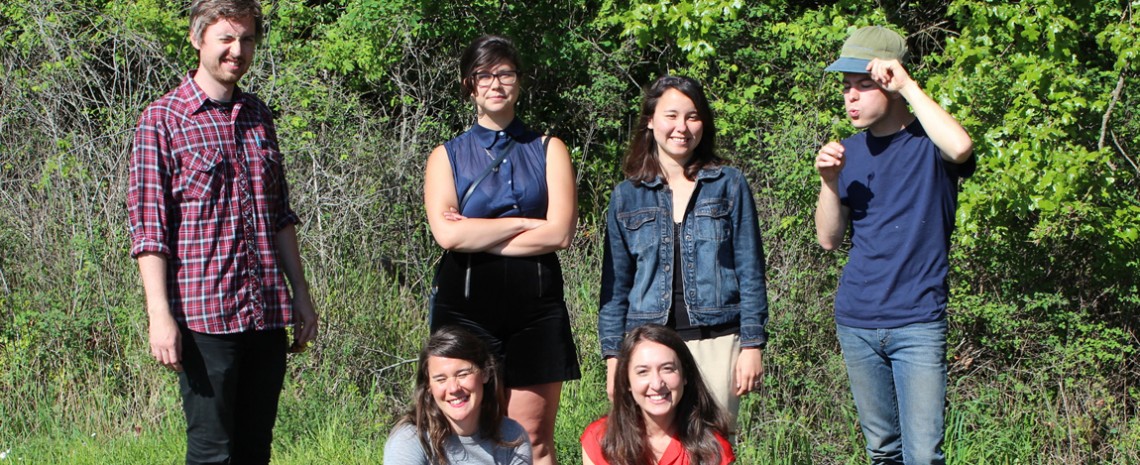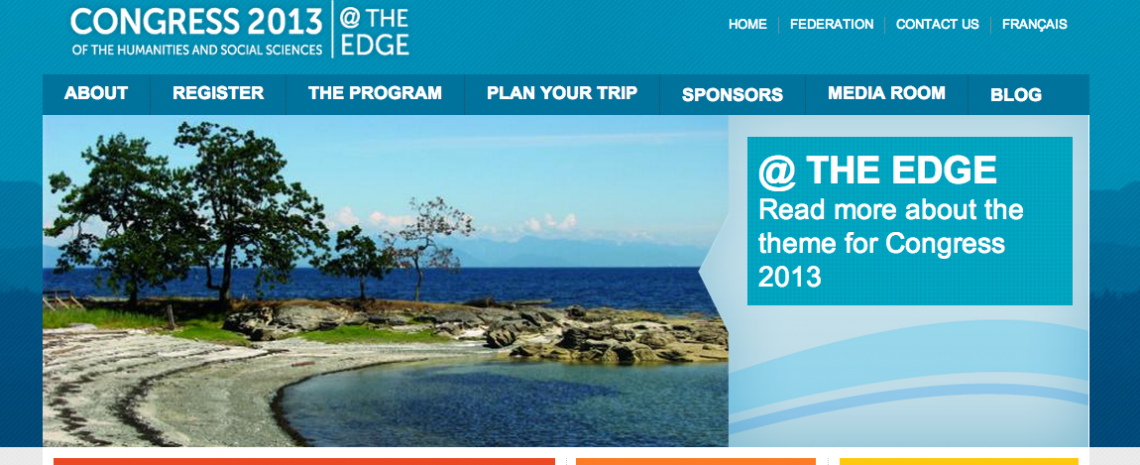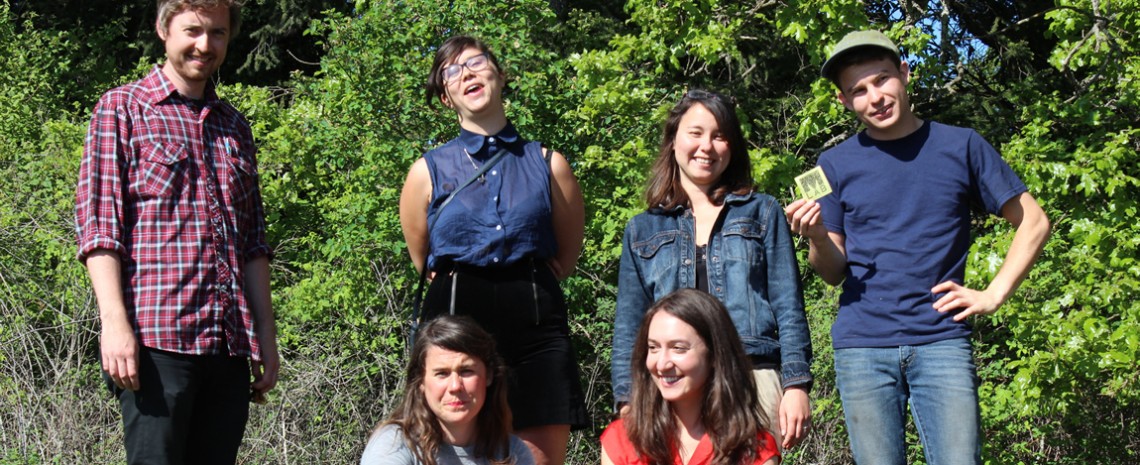During Congress 2013 at the University of Victoria this week, the Maker Lab team will be giving a variety of presentations—talks and posters included. Organized chronologically, information for all MLab presentations at Congress 2013 is below. We also want to again congratulate the MLab team members who won the Social Sciences and Humanities Research Council (SSHRC) “Research for a Better Life: The Storytellers” video contest. Six of them are pictured in the image gallery above, and during Congress Jana Millar Usiskin will be representing the storytellers team with a Monday afternoon presentation on the Audrey Alexandra Brown Exhibit. Watch the MLab team’s winning video.
From the MLab team, Adèle Barclay, Nina Belojevic, Alex Christie, Jana Millar Usiskin, Stephen Ross, Jentery Sayers, and Katie Tanigawa will be presenting at Congress 2013. Hope to see you there!
Throughout Congress 2013
“The Long Now of Ulysses: Curating literature after the Internet” | Maltwood Gallery, McPherson Library
How are interpretations of literature changing in a digital age? This student-curated exhibit engages that very question using James Joyce’s Ulysses as its tutor text with an emphasis on time, place, computation, and speculation. Audiences are invited to interact with many of the curated materials. Learn more about the exhibit.
Monday, 3 June 2013
“Research for a Better Life: The Storytellers Showcase” | 13:00 | SSHRC | McKinnon Gym, Expo Event Space | #sshrcstorytellers
The Top 25 Storytellers take the stage! With its Research for a Better Life competition, SSHRC challenged postsecondary students to show how research in the social sciences and humanities is helping us understand and improve the world around us, today and into the future. With submissions from across the country, Canada’s students met the challenge with enthusiasm, creativity and wit. Now we invite you to join the audience as the Top 25 finalists share their work in a spotlight showcase, with five winners earning an invitation to the World Social Science Forum in Montreal. Jury members include Shari Graydon, Jay Ingram, Antonia Maioni and Pierre Normand.
“A Linked Open Data Approach to the Study of Global Modernism” | 13:30 | CSDH/SCHN | SS / Mathematics A102 | #csdhschn2013
Stephen Ross (presenting author), Jentery Sayers, Adèle Barclay, and Alex Christie (presenting author)
This paper outlines the opportunity afforded by a large dataset in the field of modernist studies, and how researchers associated with the Modernist Versions Project plan to structure, deliver, and preserve it using Linked Open Data principles and methods. We describe the dataset and our methods for gathering metadata, the research questions driving the project, and what we see as its potential for producing new lines of inquiry in modernist studies and digital humanities alike. The opportunity comes in the form of the Routledge Encyclopedia of Modernism (REM), which is being edited at the University of Victoria. The REM is a digital resource consisting of 3000+ entries totaling approximately 3.5 million words, provided by over 1200 contributors. Corresponding with what Mao and Walkowitz call the “new modernist studies,” it covers modernist cultural production around the world and across the arts. Our project leverages this dataset by asking what forms of metadata will provide the richest and most usable apparatus for navigating and making the material more intuitively and readily discoverable. To this end, we have constructed a data model, taxonomy, and ontology, following the highly successful methods of the Indiana Philosophy Ontology (InPhO). On the basis of that ontology (which is a mashup of existing ontologies, including FOAF), we produced a questionnaire for distribution to the REM’s 1200 contributors, using crowdsourcing methods to ask them to specify all pertinent elements of their subjects’ sexuality, gender, ethnicity, class, media type, language, location, religion, influence, affiliation, and so forth. Our paper outlines the steps in this crowdsourcing process, as well as our plans to organize, curate, and analyze the data so that it is interoperable with other literary and cultural collections across the web. In this respect, the paper situates our project in relation to some other Semantic Web and Resource Description Framework projects, such as Linkedjazz, Out of the Trenches, and Europeana, which necessarily rely upon innovative models, interfaces, and graphical expressions to facilitate discovery, navigation, and re-use of cultural heritage materials. Recognizing both the challenges and the potential of working with Linked Open Data, we outline our strategy and will seek input from the audience on best practices, with particular attention to provenance, interoperability, and flexible infrastructure. This feedback will be integral to the ultimate aim of the project, namely to produce an intuitive and agile collection that will allow researchers from any discipline to perform complex queries and discover lines of affiliation among disparate elements of global modernism. To be sure, this large-scale, high-level, inquiry is prohibitively difficult to undertake without computational methods, collaboration, and community support.
“The Key to All Ontologies?: The Long Now of Linked Data” | 13:30 | CSDH/SCHN | SS / Mathematics A102 | #csdhschn2013
Jentery Sayers (presenting author), Susan Brown, John Simpson, Harvey Quamen, Adèle Barclay (presenting author), Alex Christie (presenting author), and the INKE Research Team
Digital scholarly communications are increasingly dynamic, collaboratively-produced texts that emphasize interlinkages across unique, distributed resources. The now popular Resource Description Framework (RDF) offers considerable potential for supporting these aspects of digital scholarly production through the creation, publication, and harvesting of public RDF in the form of Linked Data. However, RDF and Linked Data have been mobilized largely in the sciences, and very little humanities research has been conducted on either. As such, this Implementing New Knowledge Environments (INKE) paper asks what the humanities have to learn from RDF and Linked Data, and—more specifically—how each may allow scholars to explore “the kinds of humanistic phenomena” that “appear only at scale” (Liu 2012). First, for non-specialist audiences, the paper provides short summaries of key terms related to the study and practice of RDF and Linked Data. These terms include “Semantic Web,” “RDF,” “Ontologies,” “Web Ontology Language,” and “Linked Data.” It then surveys an array of existing humanities projects involving RDF, organizing them into the following categories: 1) domain-centric projects (e.g., Linked Jazz and Out of the Trenches), which build upon previously established preservation projects and extend them online; 2) aggregator projects (e.g., Europeana), which gather contextual information from disparate sites around the web and afford access to millions of scholarly materials, often through advanced visualization techniques; and 3) tools (e.g., CWRCwriter, Scalar, and SharedCanvas), which leverage the synergistic integrations promised by the growth of semantic web activities in the humanities and help scholars navigate, describe, and interpret large sums of data. Based on this survey, the INKE Research Team has concluded that humanities applications of RDF and Linked Data generally differ from those in the sciences. Whereas science-based applications tend to privilege a single structure or ontology, humanities applications focus on user-based knowledge creation and customized ontologies and approaches. The humanities emphasis is thus more about using RDF as a basis for resource interlinking and knowledge sharing than developing a “key to all ontologies,” which opens and connects all available resources. Yet this conclusion also acts as a cautionary tale for the future of RDF and Linked Data in humanities projects, namely because customized ontologies and approaches pose a number of difficulties where accessibility and interoperability are concerned. Transparency of knowledge representation and ease of use will have a major influence on how effectively Linked Data will help humanities scholars explore phenomena that appear only at scale. As such, this paper ultimately recommends that digital humanities practitioners consider the “long now” of their RDF and Linked Data projects (Eno 2003). A form of long-term thinking and responsibility, working in the long now involves designing, building, and maintaining domain-centric collections, aggregation projects, and tools that think seriously about audiences, developers, archivists, and values well off in the distance, in 2023 and beyond. It also means balancing the whiz-bang effects of digital scholarly communication with sustainable practices and data.
“Engaging the Edges of Digital Literary Studies through the TEI” | 15:15 | CSDH/SCHN | SS / Mathematics A102 | #csdhschn2013
Jana Millar Usiskin (presenting author) and Katie Tanigawa (presenting author)
In Allen Renear’s article “The Descriptive/Procedural Distinction is Flawed,” he suggests that tagging may be performative inasmuch as it is “used to create the component in question, not to report its presence.” In conversation with Renear and other scholars about best practices within the TEI community, we examine how the performative act of tagging engages issues at the edge of digital literary studies, especially the encoding of gender, race, and power. By exploring two projects that use encoding for literary criticism, we argue that TEI, when used primarily for interoperability, potentially bypasses key questions of representation by: [1] creating distinctions between empirical and subjective data; [2] excluding certain characters and spaces as viable empirical data; and [3] structurally privileging empirical data sets over subjective ones. Building on work by Wendy Chun, Tara McPherson, and Alan Liu, who investigate the intersections of digital technologies with disenfranchisement, we argue that tagging focused on interoperability risks inscribing racial and gendered hierarchies in a text. Thus, uncritical adoption of TEI for interoperability may further marginalize already marginalized groups from literary analysis. One response to issues of marginalization is project-specific tagging, which opens alternative ways of encoding characters and spaces, but may limit a document’s usefulness beyond individual interests. In order to exhibit both the limits and appeals of project-specific tagging, we highlight the difficulties of tagging for place and characters in key passages by Audrey Alexandra Brown and Joseph Conrad. For example, the <persName> and <place> tags account for certain named characters and geographically mappable spaces, at the expense of characters who represent marginalized groups (women, children, indigenous people) and the spaces occupied by these characters (domestic spaces). In both cases, tagging for interoperability reifies the marginalization of already marginalized characters and spaces within the texts and the texts’ critical apparatuses. Worse still, markup might erase the marginalized characters altogether. We demonstrate how project-specific tagging addresses these issues. Our slides show: [1] the same passage encoded with one schema that emphasizes interoperability and another that emphasizes project-specific concerns and [2] Mandala Browser visualizations of differences created when using interoperability and project specific tagging in the same text. Our initial findings suggest that for literary studies the benefits of project-specific tagging far outweigh the benefits of tagging for interoperability.
“A Method for Scaled Interpretation” | 15:15 | CSDH/SCHN | SS / Mathematics A102 | #csdhschn2013
Stephen Ross, Alex Christie, Adèle Barclay, Jentery Sayers, Katie Tanigawa, and J. Matthew Huculak (presenting author)
We begin with a series of questions: what is the best way to compare different iterations of a text using computational methods to yield meaningful results? How can we characterize difference when we find it? How can we/ought we to mark it up for display? What is the most effective means of visualizing it? What sorts of inquiry do we foreclose with each decision, and what method is most flexible, rewarding, and yet readily implemented? Our paper will address each of these questions by reporting the results of a new method we have been testing out for collating texts, marking up the variations between them, and visualizing the results to generate new critical insights. Using short texts and a “sprint” based model for testing, we have tried to identify the most efficient means of integrating computational collation into literary criticism. Our method entails 1) identifying short parcels of text in at least two different iterations, 2) preparing the text in OCR corrected plain text format, 3) collating the raw text with the Juxta tool, 4) outputting the result in TEI, 5) marking up the resulting file using a controlled vocabulary that characterizes the changes between iterations, 6) visualizing the resulting .xml file in the Mandala browser, and 7) interpreting the results as a supplement to traditional close reading. We use Git for tracking, saving, and branching the various differences that emerge, and GitHub for sharing our output. This approach contributes to Digital Humanities and modernist studies equally: it affords a flexible and scaleable method for digital collation of text without the need to create a full digital edition first, and it offers greater precision and consistency to traditional close reading practices, potentially opening up canonical texts to new interpretive possibilities. Perhaps its greatest import and innovation, however, lie in its implications for collational and versioning approaches to the computational study of literature: because it aims to read the difference between iterations of a text, our approach close reads neither one text nor the other, nor privileges one over the other, but the difference between them per se. Because the mark-up we do in step (5), above, characterizes the nature of the changes made between iterations of a given text rather than finding the difference between two characterizations of what appears in the texts, the visualizations and interpretations that result quite literally open up a new dimension of literature for close reading. We will supplement this presentation of our experimental workflow and the theory behind it with screen captures of its various stages, and conclude by presenting some of the novel readings of canonical texts we have arrived at through application of this method.
Tuesday, 4 June 2013
“Career Options for Graduate Students and Junior Scholars” | 12:15 | CSDH/SCHN | SS / Mathematics A102 | #csdhschn2013
Constance Crompton, Sean Gouglas, Aimée Morrison, Jentery Sayers, Lynne Siemens, and Stéfan Sinclair
Is there life after the degree for DH grads? Join several DH scholars at a variety of career points with a range of different experiences for a frank and informal discussion of the various and shifting job markets in DH. Academic? Alt-academic? Non-academic? Public sector? Private sector? We invite graduate students and junior scholars to a career lunch on Tuesday, June 4, from 12:15-1:15. No panel, no presentations; just sandwiches, and focused small-group conversation with people who have been in your shoes. Eat and chat with: Constance Crompton, Sean Gouglas, Aimée Morrison, Jentery Sayers, Lynne Siemens, and Stéfan Sinclair.
“Humanities Fall on the Z-Axis” and “Kits for Cultural History” | 15:00 | CSDH/SCHN | SS / Mathematics A102 | #csdhschn2013
Two posters by Jentery Sayers (presenting author), Nina Belojevic (presenting author), Alex Christie (presenting author), Jon Johnson, and the Maker Lab in the Humanities Team
Wednesday, 5 June 2013
“Digital Humanities Microclimates: Practice and the Politics/Pragmatics of Place” | 10:30 | CSDH/SCHN | SS / Mathematics A104
A special panel with Ray Siemens, Jentery Sayers, Daniel Powell, Jon Bath, Aimée Morrison, and Stéfan Sinclair
Post by Karly Wilson, attached to the ModVers, KitsForCulture, LongNowOfUly, AABrown, and Makerspace projects, with the news, fabrication, versioning, exhibits, and physcomp tags. Featured images for this post care of Jentery Sayers and the Congress 2013 website. The first and third images are photographs of Shaun Macpherson, Adèle Barclay, Katie Tanigawa, Arthur Hain, Mikka Jacobsen, and Jana Millar Usiskin.



